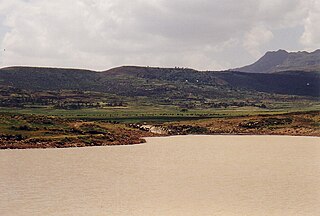Related Research Articles

The Tigray Region is the northernmost regional state in Ethiopia. The Tigray Region is the homeland of the Tigrayan, Irob and Kunama people. Its capital and largest city is Mekelle. Tigray is the fifth-largest by area, the fourth-most populous, and the fifth-most densely populated of the 11 regional states.

Hintalo Wajirat is one of the Districts of Ethiopia or woredas in the Tigray Region of Ethiopia. It is named after its largest town, Hintalo, and the Wajirat Mountains in the southern part of the woreda. Located in the Debub Misraqawi (Southeastern) Zone at the eastern edge of the Ethiopian highlands Hintalo Wajirat is bordered on the south by the Debubawi (Southern) Zone, on the west by Samre, on the north by Enderta, and on the east by the Afar Region. Other towns in Hintalo Wajirat include Adi Gudem, and Bahri Tseba.
Addi Akhor is a reservoir located in the Enderta district of the Tigray Region in Ethiopia. The earthen dam that holds the reservoir was built in 1998 by SAERT.

Addi Gela is a reservoir located in the Hintalo Wajirat woreda of the Tigray Region in Ethiopia. The earthen dam that holds the reservoir was built in 1998 by SAERT.

Addi Hilo is a reservoir located in the Inderta woreda of the Tigray Region in Ethiopia. The earthen dam that holds the reservoir was built in 1998 by SAERT.

Addi Qenafiz is a reservoir located in the Hintalo Wajirat woreda of the Tigray Region in Ethiopia. The earthen dam that holds the reservoir was built in 1998 by SAERT.

Addi Shihu is a reservoir located in the Atsbi Wenberta woreda of the Tigray Region in Ethiopia. The earthen dam that holds the reservoir was built in 1997 by SAERT.

Arato is a reservoir located in the Inderta woreda of the Tigray Region in Ethiopia. The earthen dam that holds the reservoir was built in 1997 by SAERT.

Betqua is a reservoir located in the Hintalo Wajirat woreda of the Tigray Region in Ethiopia. The earthen dam that holds the reservoir was built in 1997 by SAERT.
Dur Anbesa is a reservoir located in the Hintalo Wajirat woreda of the Tigray Region in Ethiopia. The earthen dam that holds the reservoir was built in 2001 by SAERT. The catchment of the reservoir is 10 km2 large. The reservoir suffers from rapid siltation. Part of the water that could be used for irrigation is lost through seepage; the positive side-effect is that this contributes to groundwater recharge.
Imbagedo is a reservoir located in the Inderta woreda of the Tigray Region in Ethiopia. The earthen dam that holds the reservoir was built in 1998 by SAERT.

Inda Zib'i is a reservoir located in the Inderta woreda of the Tigray Region in Ethiopia. The earthen dam that holds the reservoir was built in 1999 by SAERT.
Era is a reservoir located in the Atsbi Wenberta woreda of the Tigray Region in Ethiopia. The earthen dam that holds the reservoir was built in 1997 by SAERT.

Filiglig is a reservoir located in the Hintalo Wajirat woreda of the Tigray Region in Ethiopia. The earthen dam that holds the reservoir was built in 1998 by SAERT.

Gereb Awso is a reservoir located in the Inderta woreda of the Tigray Region in Ethiopia. The earthen dam that holds the reservoir was built in 1998 by SAERT.

Gereb Bi’ati is a reservoir located near Mekelle in the Tigray Region in Ethiopia. The earthen dam that holds the reservoir was built in 2000 by SAERT.

Gereb Mihiz is a reservoir located in the Hintalo Wajirat woreda of the Tigray Region in Ethiopia. The earthen dam that holds the reservoir was built in 1998 by SAERT.

Gereb Segen is a reservoir located in the Hintalo Wajirat woreda of the Tigray Region in Ethiopia. The earthen dam that holds the reservoir was built in 2000 by SAERT.

Gereb Segen is a reservoir located in the Inderta woreda of the Tigray Region in Ethiopia. The earthen dam that holds the reservoir was built in 2016 by the Tigray Water Bureau, with the main aim of providing Mekelle with water.

Gereb Shegal is a reservoir located in the Inderta woreda of the Tigray Region in Ethiopia. The earthen dam that holds the reservoir was built in 1998 by SAERT.
References
- ↑ Woldeab Teshome (2003). "established in 1995 for "policymaking, design and construction of dams and canals, and the maintenance of dams and water distribution systems"". Wageningen University & Research .
- ↑ Nana-Sinkam, S.C. (February 1995). "Land and environmental degradation and desertification in Africa : issues and options for sustainable economic development with transformation". United Nations Economic Commission for Africa : 11, 94.
- 1 2 Haregeweyn, Nigussie; Poesen, Jean; Nyssen, Jan; Govers, Gerard; Verstraeten, Gert; de Vente, Joris; Deckers, Jozef; Moeyersons, Jan; Haile, Mitiku (September 2008). "Sediment yield variability in Northern Ethiopia: A quantitative analysis of its controlling factors". CATENA. 75 (1): 65–76. doi:10.1016/j.catena.2008.04.011.
- 1 2 Aberra, Yohannes (September 2004). "Problems of the solution: intervention into small-scale irrigation for drought proofing in the Mekele Plateau of northern Ethiopia". The Geographical Journal. 170 (3): 226–237. doi:10.1111/j.0016-7398.2004.00122.x. JSTOR 3451254.